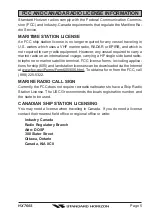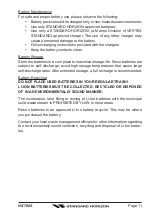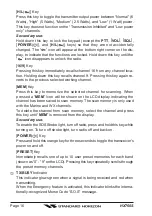
HX760S
Page 10
4. GETTING STARTED
If the radio has never been used, or its charge is depleted, it may be charged
by connecting the
CD-39
Charger Cradle with the
NC-88B
battery charger, as
shown in the illustration. If 12V DC power is available, the optional
E-DC-19A
DC Cable with 12 V Cigarette Lighter Plug or the optional
E-DC-6
DC Cable
may be used for charging the battery. The
NC-88B
,
E-DC-19A
, and
E-DC-6
will charge a completely discharged
FNB-V99LI
battery pack in about 8 hours.
4.1 BATTERIES AND CHARGERS
The
FNB-V99L
I is a high performance Li-Ion battery providing high capacity in
a compact package.
CAUTION
To avoid risk of explosion and injury,
FNB-V99LI
battery pack should
only be removed, charged or recharged in non-hazardous environments.
4.1.1 BATTERY SAFETY
Battery packs for your transceiver contain Li-Ion batteries. This type of battery
stores a charge powerful enough to be dangerous if misused or abused, espe-
cially when removed from the transceiver. Please observe the following pre-
cautions:
DO NOT SHORT BATTERY PACK TERMINALS
: Shorting the terminals that
power the transceiver can cause sparks, severe overheating, burns, and bat-
tery cell damage. If the short is of sufficient duration, it is possible to melt
battery components. Do not place a loose battery pack on or near metal sur-
faces or objects such as paper clips, keys, tools, etc. When the battery pack is
installed on the transceiver, the terminals that transfer current to the trans-
ceiver are not exposed. The terminals that are exposed on the battery pack
when it is mounted on the transceiver are charging terminals only and do not
constitute a hazard.
DO NOT INCINERATE
: Do not dispose of any battery in a fire or incinerator.
The heat of fire may cause battery cells to explode and/or release dangerous
gases.











































